Menu
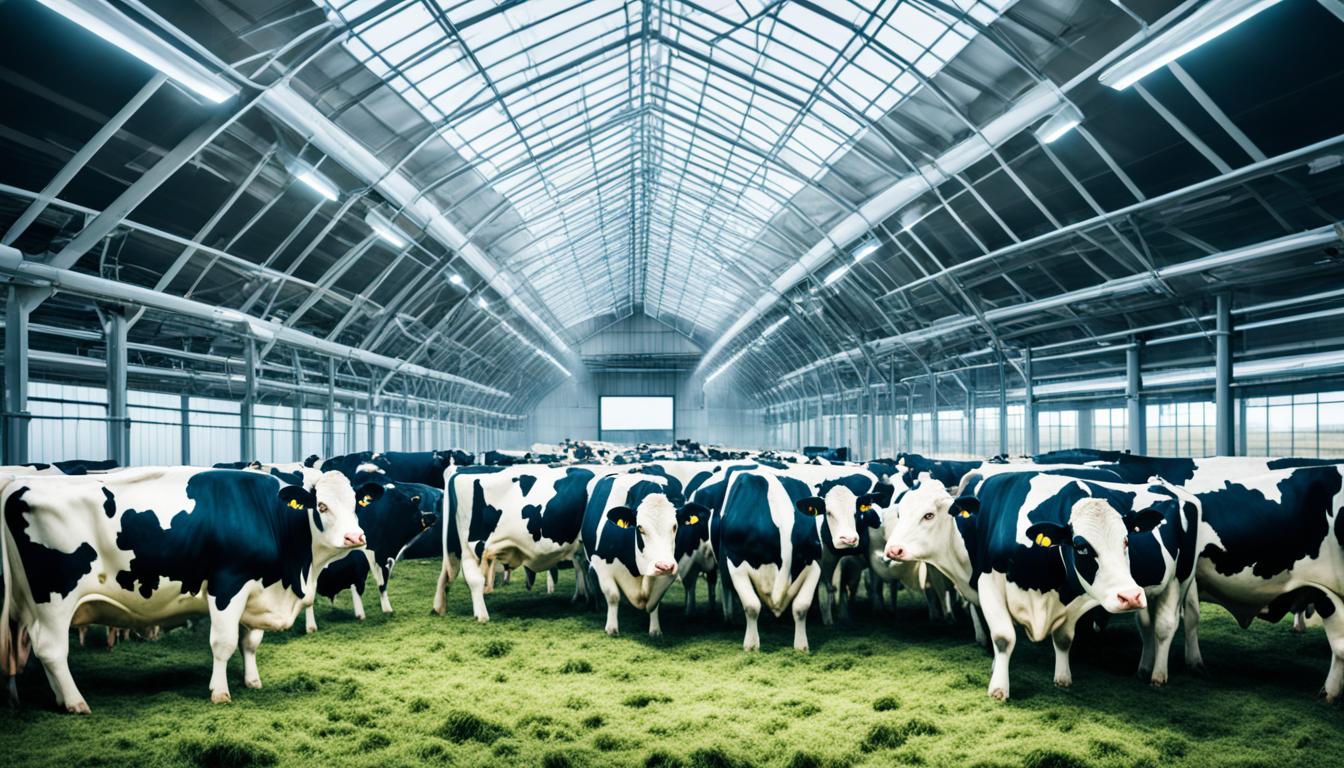
Did you know? 31.7% of calves born through in vitro procedures (IVP) weigh over 50 kg. This is more than their counterparts born from artificial insemination (AI) or embryo transfer. This shows biotechnology in livestock can greatly affect animal welfare.
Biotechnology is key in making animal lives better. It helps improve the health and happiness of livestock. Scientists use biotechnological methods to tackle issues like pain, stress, and diseases. But, we must also think about ethics.
There are downsides too. For example, LOS can cause more birth defects and deaths at birth. 3.2% of IVP calves had defects, while just 0.7% of AI calves did.
Yet, the full picture of animal welfare is complex. We must carefully look at how biotechnology affects it. Making the right choices based on ethics is essential in this area of research.
Biotechnology in livestock is changing farming in big ways. It uses advanced methods like genetic changes and cloning. The goal is to make animals healthier and produce more. Agricultural biotechnology brings great benefits through modern science.
The term definition of livestock biotechnology covers many high-tech approaches. This includes cloning and changing genes to make animals better. This field is a key part of agricultural biotechnology advances. These advances help animals be more productive and stay healthy.
Animal breeding started with picking the best animals to mate. Then, with DNA and molecular markers, the focus changed. Now, we use more accurate, efficient biotech methods. For example, in 2004, we moved about 550,000 bovine embryos worldwide. Today, we have complex bioengineering. This shows the biotech evolution in livestock.
Biotechnology is vital in today’s farming world. With many people not eating enough meat and milk, the demand is high. We need methods that are efficient and don’t harm our planet. Genetic engineering helps meet these needs. It makes farming more productive and sustainable. Using DNA tech, we can produce more food for the growing world, especially in countries needing more meat and milk.
| Region | Meat Consumption (kg/year) | Milk Consumption (kg/year) |
|---|---|---|
| Global | 42.1 | 108 |
| Developed Countries | 82.9 | — |
| Developing Countries | 31.1 | — |
| FAO Recommendation | 50 | 200 |
Reproductive biotechnologies are key in making livestock breeding more efficient. With a big increase in global meat demand expected, these methods are vital. They can help the world meet a 200% rise in meat needs by 2050 in low and middle-income countries.
Artificial insemination (AI) is a vital tool in breeding technologies. It’s great for precise genetic matches and controlling diseases. This method is less stressful for animals than traditional breeding. In South America, 20-30% of cows get AI annually, boosting calving rates and genetic improvements. In the US dairy industry, over 60% of cows are bred this way, showing its success.
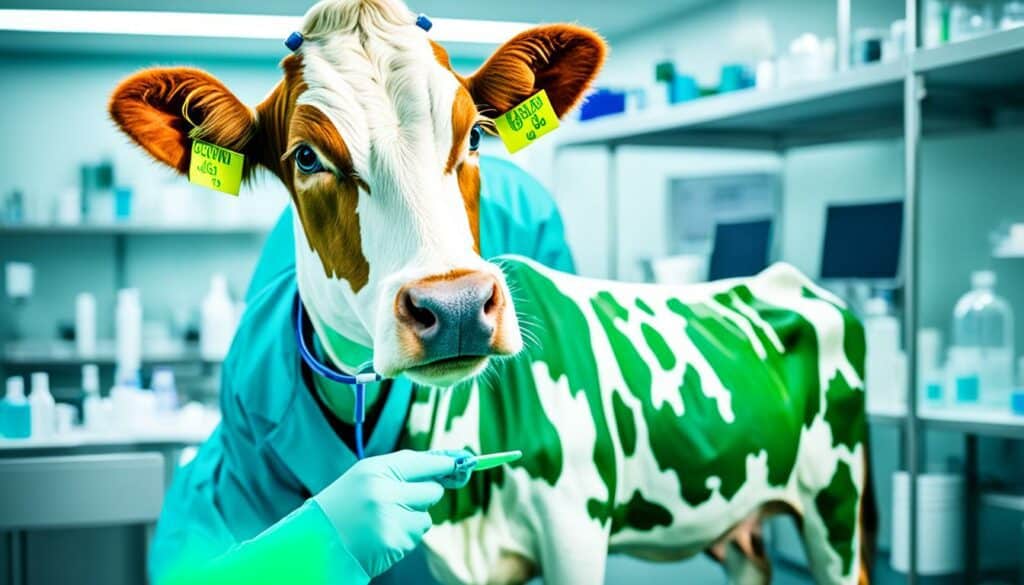
Embryo transfer (ET) is highly effective in boosting the number of offspring from top females. This helps spread desirable qualities in livestock. Every year, more than a million bovine embryos are moved around the world. When ET is combined with mRNA transfer, its positive effects are even greater. But, it’s also important to consider the animals’ well-being in all these processes.
In vitro fertilisation (IVF) is another advanced tool in livestock breeding. It can tackle issues like blocked systems or poor semen quality by creating embryos outside the animal. This is very helpful in bovine breeding, allowing for the creation of embryos from top genetics in a controlled way. Bovine IVF significantly boosts efficiency in breeding livestock sustainably and ethically.
| Technology | Application | Impact |
|---|---|---|
| Artificial Insemination (AI) | Precise genetic matching, disease control | Higher calving rates, significant herd genetic gains |
| Embryo Transfer (ET) | Increases reproductive rate, uses mRNA embryo transfer | Improved genetic traits, widespread usage |
| In Vitro Fertilisation (IVF) | Overcomes reproductive issues, controls embryo environment | Enhanced livestock reproductive efficiency, ethical production |
Gene editing, especially with CRISPR-Cas9, has changed how we look at animal health. It targets specific genes to enhance disease resistance and other key traits in animals. This has benefits for the animals and the work scientists do.
Gene editing uses methods to change the genes of animals. The techniques, like CRISPR-Cas9, allow us to change DNA precisely. This can make animals more productive, improve the quality of food, and help the environment. For example, pigs and sheep have been edited to grow faster.
CRISPR-Cas9 is leading to better animal welfare. It can edit out disease risks before animals suffer. It lets us make animals immune to diseases or more resistant to them. But we must ensure these animals’ long-term welfare, which means we must be careful and ethical in our work.
For example, the Enviropig™ shows how gene editing can help the environment. These pigs produce an enzyme that decreases pollution from farms. And goats that make human lysozyme in their milk show how gene editing improves food. Despite concerns, these advances have real benefits and show the need for discussions on ethics.
The use of genetic engineering in agriculture is growing. It’s changing how we take care of animals and their health. With each step, we dream of a future with healthier, more eco-friendly animals.
| Genetically Engineered Traits | Benefits |
|---|---|
| Higher growth hormone levels in pigs and sheep | Increased productivity |
| Omega-3 enriched pigs | Enhanced food quality |
| Human lysozyme in goat milk | Improved nutritional value |
| Enviropig™ | Reduced agricultural pollution |
Genetic changes are making huge strides in improving the health of farm animals. This work includes making animals less likely to get certain diseases through genetic tweaks. The goal is to help animals stay healthy, and this method has many tools and ways to work.
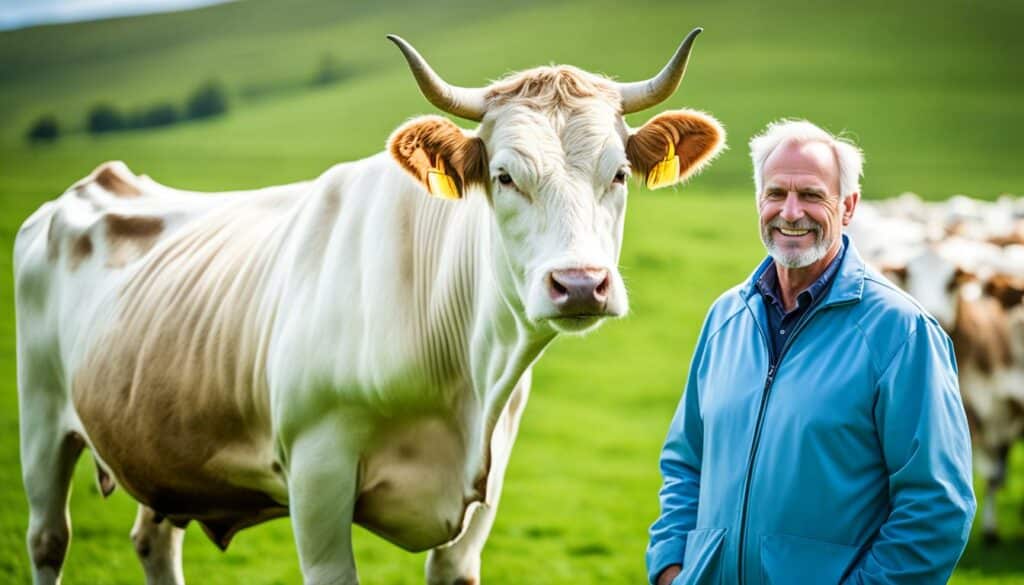
Through genetic work, animals can fight diseases better than before. Scientists are finding ways to alter genes to make animals more disease-resistant. A great example is pigs that can fight off harmful viruses, showing how powerful these changes can be.
This approach is changing the game for animal health. It cuts down on sickness and means animals might not need as much medicine, like antibiotics. So, it’s good for animal wellbeing and lessens the chances of diseases spreading.
Yet, we need to watch how these changes affect the animals’ wellbeing over time. We must make sure they aren’t causing other problems for them.
There are already some exciting successes in making animals healthier. For instance, dairy cows have been changed to fight off mastitis, a big problem. Also, the Enviropig™ can manage its diet in a way that helps the environment. These are great examples of how genetic changes can improve animal health and tackle big issues head-on.
The livestock industry has changed a lot thanks to biotechnology. It brings big steps in how well animals grow, what they eat, and how we look after the planet. Now, animals grow better and use food more wisely.
Breeding animals has got a lot more efficient. Using genetic markers, selecting the best animals is quicker. This means we get better meat and milk, perfect for the world’s increasing demands.
Animals now eat more efficiently, thanks to biotech. Enzymes and other products are helping them absorb more nutrients from their food. This includes using ProAct 360™ to reduce pollution and waste while increasing the food’s usefulness.
Biotech is also tackling the pollution from farms. Livestock farming contributes a lot to our greenhouse gas problem. But, by improving how animals eat and what they produce, we’re looking after the planet better. Using enzymes like Ronozyme® HiPhos makes water cleaner, and it cuts down on harmful gases.
Focusing on sustainable farming is key for the future. It means we can keep growing food without hurting our planet. This is why biotech is so important – it helps the livestock industry be part of a cleaner, more sustainable world.
| Country | Average Per Capita Meat Consumption (kg/year) | Milk Consumption (kg/year) |
|---|---|---|
| Developed Countries | 82.9 | 108 |
| Developing Countries | 31.1 | 108 |
Ethical issues in biotechnological applications are key in managing livestock today. Biotechnology rules hugely affect the study and its use. We need to grasp the complex ethical issues linked to technology’s growth.
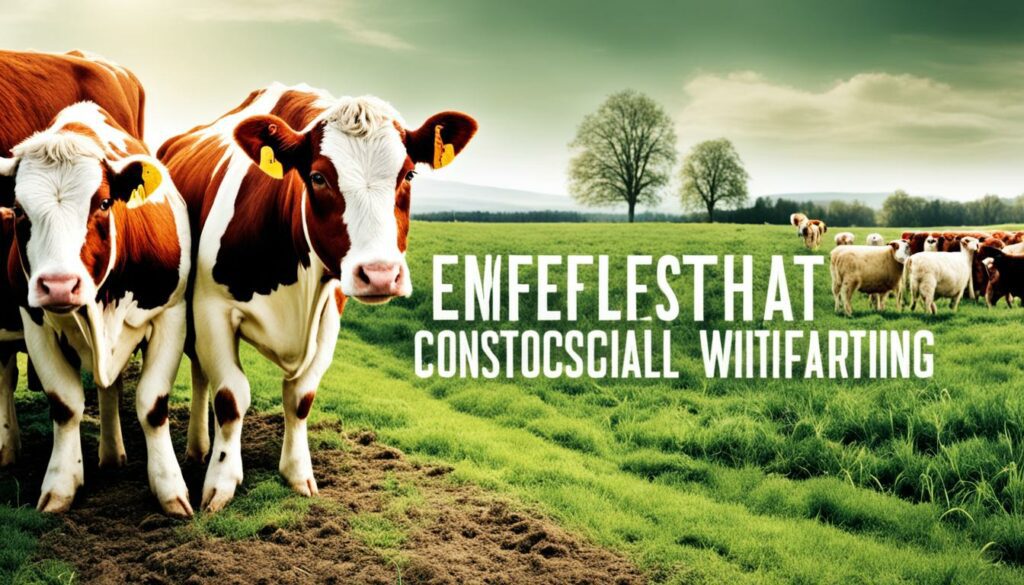
Public views on animal biotechnology vary due to different cultural beliefs. Practices like genetic engineering provoke big ethical debates. This is because these methods are intrusive and can cause unanticipated harm. Cloning, especially in animals like cats and dogs, adds to these worries. Bioethical considerations try to understand and address these fears, but also consider scientific progress and respect for cultural morals.
Setting rules in biotechnology is vital to ensure its ethics meet general and animal welfare needs. Regulating bodies worldwide are adjusting to new technologies and the growing ethical concerns. They look into issues such as animals’ wellbeing in deep procedures and the use of many animals in studies. In the UK and the US, key groups hand down and oversee these rules.
Deciding how to balance ethics with the need for scientific growth is crucial. Many genetically altered animals are still in the study phase. It’s important to check how these changes might affect the animals before they’re used more widely. This involves looking closely at the genetic changes in both pets and farm animals. Those in the field of bioethics, along with vets and policymakers, work together to set principles that encourage ethical progress without harming animals.
| Technology | Application | Ethical Considerations |
|---|---|---|
| Gene Editing | Improved disease resistance in livestock | Unanticipated welfare issues, invasiveness of procedures |
| Reproductive Cloning | Cloning of companion and farm animals | Animal welfare concerns, acceptance by conservationists |
| Transgenesis | Enhanced productivity, better food quality | Ethical boundaries, public resistance |
Animal cloning has come a long way with methods like somatic cell nuclear transfer. However, it raises big welfare concerns. It’s crucial to look after cloned animals due to the process’s complexity and possible effects.
The main method for cloning livestock is SCNT. This method makes animals with the same DNA. Although it aims to keep good genetic traits, using SCNT meets challenges in efficiency and ethics.
Cloning can really affect animal health. Cloned animals often have more health issues and deformities. For example, they might suffer from LOS, which can make them too big or affect their birth times. The methods used in cloning can also stress the animals, like invasive techniques on cattle and goats.
Despite concerns, research in animal cloning marches on. Experts aim to boost efficiency and lower risks. They work on better SCNT, trying to understand and fix problems like LOS. They are also focused on reducing issues during and after birth, such as dystocia.
Using cloning in farming is important but brings questions. It helps keep genetic lines and boosts farm work. So, it’s key to keep making cloning methods better while caring for the animals well.
Today, the livestock industry aims to improve reproductive efficiency. It does this by using artificial insemination (AI), embryo transfer (ET), and in vitro fertilisation (IVF). These methods help in sustainable and ethical livestock production.
In South America, fixed-time artificial insemination (FTAI) is widely used. About 20 to 30% of cows take part in these big programmes each year. This method makes breeding more controlled and predictable. It has led to impressive pregnancy rates, especially in Italian buffaloes.
The use of biotechnology in livestock breeding is becoming more important. In vitro embryo production can be a success 50% to 70% of the time in twin cows. For commercial cattle, embryo transfer has a success rate of 65%. This shows how effective these methods are in farming today.
| Region | Technique | Success Rate |
|---|---|---|
| South America | FTAI | 20-30% annually |
| Italy | AI with sexed semen (buffalo heifers) | 76-79% |
| Various | IVF (mono cows) | 50-70% |
| Commercial cattle | Embryo Transfer | 65% |
In the future, the demand for meat will greatly increase, especially in poorer countries. Biotechnology in breeding livestock is key to meeting this demand. With South America being a major player in the beef market, these advancements are essential.
Advances in these technologies focus on efficiency and animal welfare. By carefully selecting and using these methods, we can meet the world’s growing need for meat. Also, we can do it in a way that doesn’t harm the environment and respects animal welfare.
The livestock industry constantly seeks better feed solutions. Biotechnology is at the heart of this quest, making nutrition more efficient and feeds more suitable for animals. It creates bioengineered feed aimed at improving how animals digest and intake nutrients.

Genetically modified (GM) feed is now a key part of animal nutrition. It improves feed crops by adding useful traits, which makes them more nutritious and easier to digest. For example, enzymes like cellulase help break down tough cellulose, making roughage easier to digest. Also, white rot fungi are very effective at breaking down fibrous materials in feed.
Biotechnology brings many nutritional improvements. It boosts the availability of nutrients and enhances feed quality. Adding probiotics and prebiotics to feed keeps the gut of farm animals healthy. This promotes their general well-being.
Chemical and physical treatments prevent protein from breaking down too early in digestion. This ensures animals obtain the full benefit of their feed. Moreover, the use of calcium salts on fats keeps essential nutrients intact.
The lasting health effects and safety of biotech feeds are very important. Ongoing research is critical to guarantee these solutions are safe for animals and humans. Removing anti-nutritive factors, like protease inhibitors, from feed supports long-term health goals.
By focusing on improving animal nutrition and health, we contribute to feeding the world sustainably. This supports the global food demand in a way that is both efficient and safe.
In the field of livestock disease management, new technology is making big changes. Biotech surveillance tools help farmers keep a closer eye on their animals’ health. These tools are getting even better with genetic engineering, which allows us to find and control diseases earlier.
Recent research shows just how vital this progress is. A big study involved 25 new research articles, 5 reviews, and 3 systematic reviews. It also included 1 method article, all pointing out how technology is key in fighting diseases. This work had 212 top researchers interested, showing a big, worldwide effort.
Genetic engineering plays a crucial role in disease management. It uses genome editing to change DNA in very specific ways. This means we can target diseases more accurately. Plus, tools like WGCNA help spot how genes work together. This knowledge is crucial for fighting diseases in smart ways.
Another area of study is miRNAs, tiny molecules that control when and how our genes do their jobs. They have a big impact on our body’s cells and health. Knowing exactly how genes work lets us fight diseases more carefully.
| Area of Improvement | Techniques/Tools | Benefits |
|---|---|---|
| Genetic Selection & Breeding | Selectable traits, miRNAs | Enhanced disease resistance, increased productivity |
| Genome Editing | Programmable DNA nucleases, WGCNA | Accurate alterations, early disease detection |
| Probiotics & Supplements | Probiotic complexes, Cr supplementation | Improved immune response, increased milk production |
Using these biotechnological tools is not just about spotting diseases early. It’s also about making animals healthier. By combining biotech surveillance tools with genetic engineering, we’re changing the game. This approach marks a big step towards better and safer ways to raise livestock.
Biotechnology has changed the way we breed livestock. It has introduced genetic marker-assisted selection. This means we can now choose animals with the best traits more accurately and quickly.
New selective breeding methods have made livestock healthier and more productive. Before, methods were simpler. Now, we use tools like genetic marker-assisted selection.
This shift is clear. Over 550,000 bovine embryos have been made using this method. It works for sheep and goats too. This shows it can be used worldwide on a big scale.
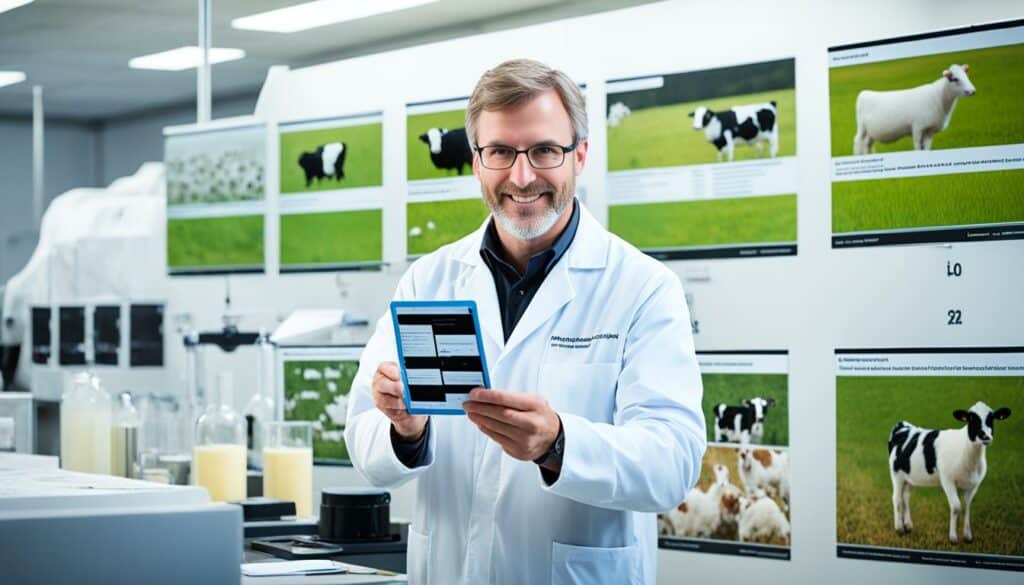
Genetic markers are key in breeding livestock now. They make it faster and easier to get the traits we want. This means we need to do less backcrossing, saving time and money.
These markers are especially helpful for making animals that resist diseases or produce more. They’ve helped the cattle meat industry grow, now worth $385 billion globally.
The future of livestock breeding looks bright, thanks to new biotech. We already have genomes of key animals, with more on the way.
This means we might see a lot of new advancements soon. By 2050, we could need double the meat and milk we do now. But, biotech can make farming more sustainable, helping the environment.
Using genetic markers and new breeding techniques is exciting. They’re not just helping us keep up with demand. They’re also making sure animals are well cared for and that farming is sustainable.
GMOs are making big changes in animal farming. They help animals grow better, have more nutrients, and fight sickness. The agriculture sector uses genetic changes to improve animal health. But, doing this needs strict rules and careful checks to keep it safe and ethical.
Now, in animal farming, we change animals like pigs and sheep to grow bigger. A gene edit in pigs makes them produce more omega-3. Goats can now make human lysozyme in their milk, boosting its nutrition.
Also, there are animals made to fight diseases or resist certain sicknesses. This helps farms be more efficient and cost-effective.
Making animals genetically different raises questions about health and food safety. It’s key to make sure these changes are safe for animals and us. In the U.S., the FDA and others watch carefully over animals like AquAdvantage Salmon and GalSafe pig. They do lots of tests to check if these changes are OK.
There’s a lot of care in how GMO animals are used. Policies worldwide try to make sure these changes are for the good of animals and the food we eat. They aim to encourage new ideas while also keeping animals and food safe and ethical.
| Attribute | Example | Benefits |
|---|---|---|
| Growth Hormone Levels | Pigs, Sheep | Increased Productivity |
| Omega-3 Production | Pigs | Enhanced Nutritional Value |
| Human Lysozyme Expression | Goats | Improved Milk Nutrition |
| Disease Resistance | Various Species | Improved Health and Efficiency |
Many people have different views on biotechnology. They are making great progress in understanding how we feel about changing genes, especially in animals. A recent survey in the US found that most people, about 65.7%, like the idea of making cows without horns. They see it as a good thing because it helps the cows and means they don’t have to go through painful procedures.
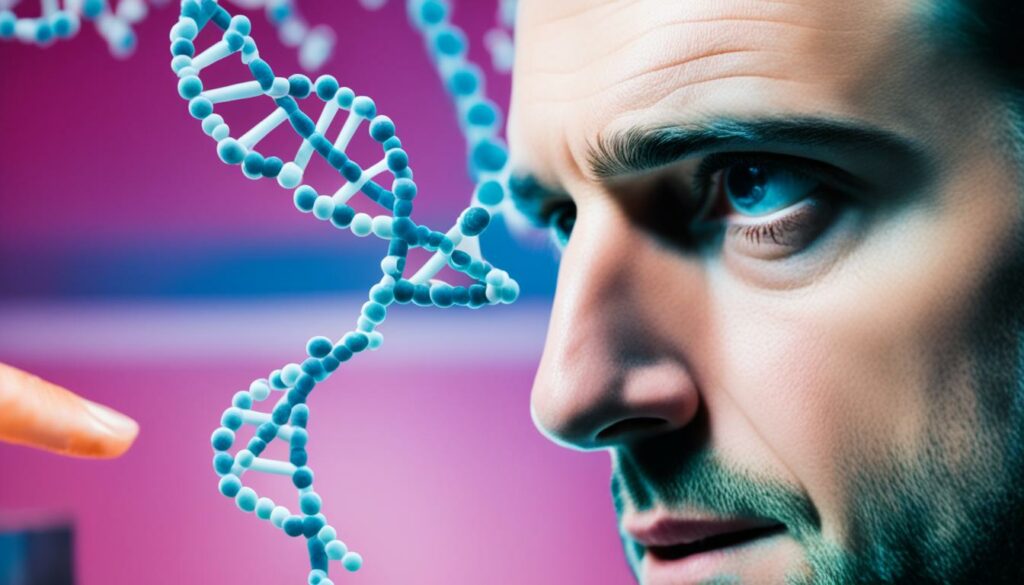
More than half of the people in the survey, about 66.0%, said they would eat food from cows without horns. But, some people worry about if tampering with genetics is natural or safe in the long run. About 45% of Americans are quite worried about eating these foods.
To get more people to like genetic changes in animals, being open and talking about it is vital. If we show the good points, like healthier animals and less illness, it could help calm these worries. And we must talk about the right and wrong of doing this, as it is a big part of what people think.
| Attitudinal Metric | Percentage |
|---|---|
| Support for hornless cows | 65.7% |
| Opposition to hornless cows | 23.1% |
| Willing to consume GM hornless cattle | 66.0% |
| Not willing to consume GM hornless cattle | 22.6% |
How people feel about animal biotechnology is shaped by many factors. Different cultures and places have their own opinions about changing genes. This shows we need to keep talking and studying to match what we do with what people want.
“Close to 40% of US consumers express willingness to buy genetically modified foods, indicating a gradual shift in societal perception, albeit with remaining concerns about naturalness and ethics.”
In conclusion, as more people learn, their views on genetic changes are becoming more positive. But to truly win people over, talking openly, educating, and considering the ethics are essential. These steps are key to dealing with the many thoughts people have on the matter.
By 2050, the world’s population will reach over 9 billion. This means we need more food. Livestock biotechnology helps cut down on greenhouse gases. For example, adding certain enzymes to animal feed lowers nitrous oxide and methane.
These gases trap heat much better than carbon dioxide. Methane is 25 times more effective at this. So, it’s key to use the right feed to lower these gases.
Using ProAct in the diet of broiler chickens reduces nitrogen emissions. This cuts four tons of nitrogen for every million chickens. It shows how livestock biotech helps with environmental issues. Enzymes not only boost animal health but also lower harmful emissions.
Alterion® probiotics have also helped poultry. They improve the balance of microorganisms. This indirectly leads to less harmful gas being released.
Biotechnology is key in managing waste sustainably in farming. It helps animals use nutrients better. For example, certain enzymes reduce phosphorus in manure. This means less phosphorus leaks into water, making it cleaner.
This approach also stops extra nutrients from polluting the environment. It fits with good waste management practices.
Biotechnological progress makes animals change feed into meat or milk more efficiently. This lowers the impact of livestock farming on the environment. The US dairy industry in 2007 used less resources than before, thanks to biotech. This shows how these solutions can reduce the need for resources in farming.
Biotechnology in livestock uses techniques like genetic modifications and cloning. These methods aim to improve productivity, disease resistance, and health. They help by reducing pain, stress, and disease risks in animals.
In the past, livestock biotechnology started with selective breeding. Now, we have advanced to genetic engineering and cloning. These advancements have greatly improved animal health and productivity in modern agriculture.
Important reproductive technologies today include AI, ET, and IVF. They allow for precise genetic matching, increased reproduction, and solving reproduction problems. But, they also raise welfare issues.
Gene editing with CRISPR-Cas9 can make specific changes to genes. This focuses on disease resistance and other key traits. By doing this, we can stop diseases before they even start, which is a big win for animal welfare.
Genetic modifications in livestock can lower disease risks. They make animals naturally resistant to certain illnesses. This improves their health and welfare.
Biotechnology makes animals grow faster and use nutrients better. This leads to better productivity and less environmental harm. It helps lower greenhouse gas emissions and manage waste well.
Issues include how the public and cultures view genetic work and cloning. These views affect laws and rules, trying to balance progress with what’s right for animals.
Cloning animals has risks such as losing pregnancies and birth defects. Researchers aim to make cloning more efficient and safer for these animals.
Biotechnology makes reproduction more efficient with AI, ET, and IVF. This means better success and less invasive methods. It’s all about making animals healthier and happier.
Modified feeds improve what animals eat and how they digest it. This boosts their health and the amount of food they produce. Research makes sure these feeds are good for animals and people.
Advanced tools help spot and control diseases early. This leads to better care and stops illnesses from spreading. It’s a big win for animal welfare on farms.
Biotechnology has changed breeding by using genetic markers and genomics. This lets us pick the best traits early. It’s been a big change in how we breed animals.
Now, we use GMOs to make animals grow faster, be healthier, and resist diseases. There are strict safety rules and ethical guidelines. These are to ensure animals are treated well and the food we eat is safe.
What people think and feel about biotechnology really matters. Being open and sharing information about its benefits helps a lot. It’s about making sure everyone understands the good sides and hard choices.
Biotechnology helps by creating animals that need less food and produce less waste. This cuts down on the pollution from farms. It’s a big help for keeping our planet healthy.